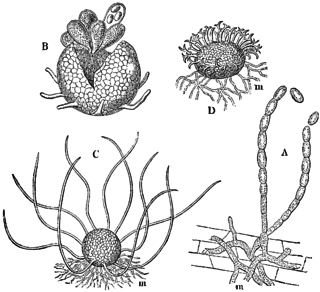
Brassicaceae or Cruciferae is a medium-sized and economically important family of flowering plants commonly known as the mustards, the crucifers, or the cabbage family. Most are herbaceous plants, while some are shrubs. The leaves are simple, lack stipules, and appear alternately on stems or in rosettes. The inflorescences are terminal and lack bracts. The flowers have four free sepals, four free alternating petals, two shorter free stamens and four longer free stamens. The fruit has seeds in rows, divided by a thin wall.

Alliaria petiolata, or garlic mustard, is a biennial flowering plant in the mustard family (Brassicaceae). It is native to Europe, western and central Asia, north-western Africa, Morocco, Iberia and the British Isles, north to northern Scandinavia, and east to northern Pakistan and Xinjiang in western China.

Pieris, the whites or garden whites, is a widespread now almost cosmopolitan genus of butterflies of the family Pieridae. The highest species diversity is in the Palearctic, with a higher diversity in Europe and eastern North America than the similar and closely related Pontia. The females of many Pieris butterflies are UV reflecting, while the male wings are strongly UV absorbing due to pigments in the scales.

Pieris oleracea, or more commonly known as the mustard white, is a butterfly in the family Pieridae native to a large part of Canada and the northeastern United States. The nearly all-white butterfly is often found in wooded areas or open plains. There are two seasonal forms, which make it distinct from other similar species. Because of climate change, populations are moving further north.

Pieris virginiensis, the West Virginia white, is a butterfly found in North America in the Great Lakes states, along the Appalachians from New England to Alabama, and in southern Ontario. They are typically found in moist deciduous forests. Forestry, development, and a highly-invasive species that it confuses with its host plant (Cardamine) are causing this species to decline.

Erysiphe cruciferarum is a plant pathogen of the family Erysiphaceae, which causes the main powdery mildew of crucifers, including on Brassica crops, such as cauliflower, cabbage, broccoli, and Brussels sprouts. E. cruciferarum is distributed worldwide, and is of particular concentration in continental Europe and the Indian subcontinent. E. cruciferarum is an ascomycete fungus that has both sexual and asexual stages. It is also an obligate parasite that appears to have host specificity; for example, isolates from turnip will not infect Brussels sprout, and vice versa. While being a part of the family Erysiphaceae, it belongs to those members in which the conidia are formed singly and whose haustoria are multilobed.

Diplotaxis tenuifolia is a species of flowering plant in the mustard family known by the common name perennial wall-rocket. It is native to Europe and West Asia, where it grows on disturbed ground and roadsides, and it can now be found throughout much of the temperate world where it has naturalized. In recent years it has increasingly been cultivated to produce salad leaves, which are marketed as wild rocket in Britain or arugula in the US. It is easily confused with garden rocket, which has similar uses.

Ceutorhynchus is a genus of true weevils in the tribe Ceutorhynchini. There are at least 400 described species in Ceutorhynchus.

Ceutorhynchus americanus is a species of true weevils in the tribe Ceutorhynchini. It is found in Alaska, United States, as well as Ontario, Canada. It feeds on the stems of Raphanus raphanistrum.
Ceutorhynchus elegans is a species of true weevils in the tribe Ceutorhynchini. It has a palaearctic distribution.

Garlic mustard was introduced to North America as a culinary herb in the 1860s and it is considered an invasive species in much of North America. As of 2020 it has been documented in most of the Eastern United States and Canada, with scattered populations in the west. It is listed as a noxious or restricted plant in the following states: Alabama, Connecticut, Massachusetts, Minnesota, New Hampshire, Oregon, Vermont, and Washington. A current map of its distribution in the United States can be found at the Early Detection and Distribution Mapping System (EDDmapS).
Ceutorhynchus semirufus is a species of minute seed weevil in the family Curculionidae. It is found in North America.
Ceutorhynchus medialis is a species of minute seed weevil in the beetle family Curculionidae. It is found in North America.
Ceutorhynchus subpubescens is a species of minute seed weevil in the beetle family Curculionidae. It is found in North America.
Ceutorhynchus anthonomoides is a species of minute seed weevil in the beetle family Curculionidae. It is found in North America.
Ceutorhynchus disturbatus is a species of minute seed weevil in the beetle family Curculionidae. It is found in North America.
Ceutorhynchus oregonensis is a species of minute seed weevil in the beetle family Curculionidae. It is found in North America.
Ceutorhynchus rapae, the cabbage curculio, is a species of minute seed weevil in the beetle family Curculionidae. It is found in North America and Europe. It feeds on Erysimum crepidifolium, Erysimum cheiranthoides, and Capsella bursa-pastoris.
Ceutorhynchus lecontei is a species of minute seed weevil in the beetle family Curculionidae. It is found in North America.

Aubrieta libanotica, common name Lebanese rock cress, is a species of flowering plant in the mustard family Brassicaceae. The genus is named after Claude Aubriet, a French flower painter. A. Libanotica is native to the mountainous ranges of Lebanon and some parts of Syria.










